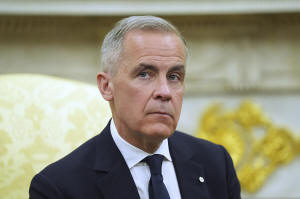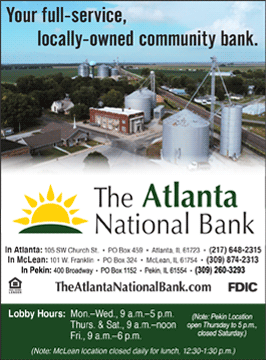Trump, Carney faceoff in Oval Office leaves gaping differences on
tariffs, 51st state
[May 07, 2025]
By ROB GILLIES and JOSH BOAK
WASHINGTON (AP) — U.S. President Donald Trump and Canadian Prime
Minister Mark Carney faced off in the Oval Office on Tuesday and showed
no signs of retreating from their gaping differences in an ongoing trade
war that has shattered decades of trust between the two countries.
The two kept it civil, but as for Trump’s calls to make Canada the 51st
state, Carney insisted his nation was “not for sale” and Trump shot
back, “time will tell.”
Asked by a reporter if there was anything Carney could tell him to lift
his tariffs of as much as 25% on Canada, Trump bluntly said: “No.”
The U.S. president added for emphasis, “Just the way it is.”
Carney acknowledged that no bit of rhetoric on tariffs would be enough
to sway Trump, saying that “this is a bigger discussion."
“There are much bigger forces involved,” the Canadian leader continued.
“And this will take some time and some discussions. And that's why we're
here, to have those discussions."
The meeting between the two leaders showcased the full spectrum of
Trump's unique mix of aggression, hospitality and stubbornness.
Shortly before Carney's arrival, Trump insulted Canada by posting on
social media that the United States didn't need “ANYTHING” from its
northern neighbor, only to then turn on the charm and praise Carney's
election win in person before showing his obstinance on matters of
policy substance.
Carney won the job of prime minister by promising to confront the
increased aggression shown by Trump, even as he has preserved the calm
demeanor of an economist who has led the central banks of both Canada
and the United Kingdom.

At times, Carney struggled to interject his views and raised his hand to
talk as Trump held forth at length and veered between topics, touching
on California Democratic Gov. Gavin Newsom, Carney’s predecessor, Justin
Trudeau, and teasing a “great” upcoming announcement that's “not
necessarily on trade.”
Trump offended Canada's sense of pride and friendship by saying he wants
to make Canada the 51st U.S. state and levying steep tariffs against an
essential partner in the manufacturing of autos and the supply of oil,
electricity and other goods. The outrage provoked by Trump enabled
Carney’s Liberal Party to score a stunning comeback victory last month
as the trade war and attacks on Canadian sovereignty have outraged
voters.
Trump said the two would not discuss making Canada part of the U.S.,
even as he insisted the idea would lead to lower taxes for Canadians.
“It’s not for sale,” Carney said. “It won’t be for sale. Ever. But the
opportunity is in the partnership and what we can build together.”
Trump persisted by saying that the United States did not want to buy
autos from Canada, even if the vehicles were also assembled in America.
The U.S. leader insisted that the $63 billion trade deficit in goods —
which he inflated to $200 billion — was a subsidy that needed to come an
end.
The meeting never devolved into the outburst that the public saw in
Trump's meeting with Ukrainian President Volodymyr Zelenskyy, who was
berated by the U.S. president and his team for not being sufficiently
deferential. Nor did it have the ease of Trump's sit down with the
United Kingdom's Prime Minister Keir Starmer, who invited Trump for a
visit provided by King Charles III.
Carney later described his conversation with Trump as “wide ranging” and
“constructive,” telling reporters that the prospect is there for
positive negotiations but there would be “zigs and zags.” Carney said he
stressed the value that Canadian companies and factories created for
U.S. automakers while stressing that it was unfair to assume one meeting
could resolve any differences.
“I wouldn’t have expected white smoke coming out of this meeting,”
Carney said after the Tuesday meeting, referencing the signal that a new
pope has been selected.
Carney said that he privately asked Trump to stop calling Canada the
51st state during their meeting. But when pressed on how Trump
responded, the Canadian prime minister said: “He’s the president. He’s
his own person.”

[to top of second column]
|

Canadian Prime Minister Mark Carney listtens to questions during a
meeting with President Donald Trump in the Oval Office of the White
House, Tuesday, May 6, 2025, in Washington. (AP Photo/Evan Vucci)

Trump was later asked if he would give Carney the same “governor”
nickname that he had put on Trudeau. The nickname was a slight meant
to imply that Canada's leader would eventually be just one of many
U.S. governors.
“As far as calling him Gov. Carney, no, I haven’t done that yet, and
maybe I won’t,” Trump said. “I did have a lot of fun with Trudeau.
But I think this is, this is a big step. It’s a good step up for
Canada.”
Trump added that the meeting with Carney had been “great” and that
he thought the ongoing relationship would be “strong.”
A senior Canadian government official said the president asked
Carney his perspective on a variety of foreign policy issues
including Iran, Russia, Ukraine and China. The official, who spoke
on condition of anonymity as they were not authorized to speak
publicly about the matter, said Trump was looking forward to the G-7
meeting in Alberta, Canada.
The stakes of the meeting were high and the messages beforehand
mixed. Trump told reporters on Monday that he wasn't quite sure why
Carney was visiting.
“I’m not sure what he wants to see me about,” Trump said. “But I
guess he wants to make a deal.”
U.S. Commerce Secretary Howard Lutnick further stoked doubts about
their interest in repairing the relationship with Canada in a Monday
interview on Fox Business Network's “Kudlow” show.
Asked if the U.S. could make a deal with Canada, Lutnick called the
country a “socialist regime” that has been “basically feeding off
America." Lutnick said Tuesday's meeting would be “fascinating.”
Carney, at a Friday news conference ahead of his trip, said the
talks would focus on immediate trade pressures and the broader
economic and national security relationships. He said his
“government would fight to get the best deal for Canada” and “take
all the time necessary” to do so, even as Canada pursues a parallel
set of talks to deepen relations with other allies and lessen its
commitments with the U.S.
Trump has maintained that the U.S. doesn’t need anything from
Canada. He is actively going after a Canadian auto sector built
largely by U.S. companies, saying, “They’re stopping work in Mexico,
and they’re stopping work in Canada, and they’re all moving here.”
He also said the U.S. doesn’t need Canada’s energy — though nearly
one-fourth of the oil that the U.S. consumes daily comes from the
province of Alberta.

The president has also disparaged Canada's military commitments
despite a partnership that ranges from the beaches of Normandy in
World War II to remote stretches of Afghanistan. He said on Tuesday
with Carney that the U.S. would continue to provide national
security support to Canada.
Trump has imposed 25% tariffs on steel and aluminum and tariffs on
other products outside the United States-Mexico-Canada Agreement, in
some cases ostensibly to address relatively low volumes of fentanyl
intercepted at the northern border. That has jeopardized a closely
entwined trade relationship as Canada sees an increasing need to
build relations with the European Union and other nations.
Canada is the top export destination for 36 U.S. states. Nearly $3.6
billion Canadian (US$2.7 billion) worth of goods and services cross
the border each day. About 60% of U.S. crude oil imports are from
Canada, and 85% of U.S. electricity imports are from Canada.
Canada is also the largest foreign supplier of steel, aluminum and
uranium to the U.S. and has 34 critical minerals and metals that the
Pentagon is eager for and investing in for national security. Canada
is one of the most trade-dependent countries in the world, and 77%
of Canada’s exports go to the U.S.
All contents © copyright 2025 Associated Press. All rights reserved |